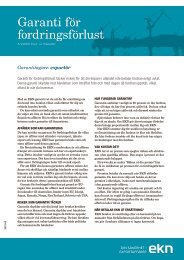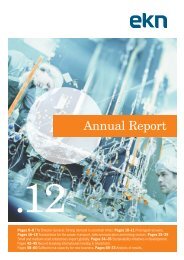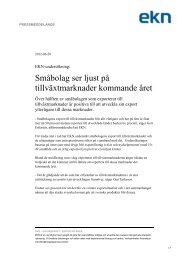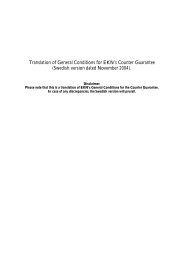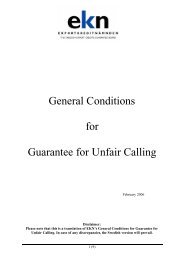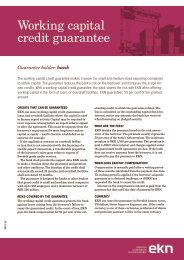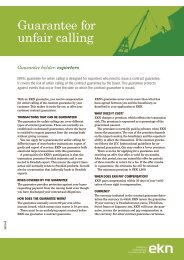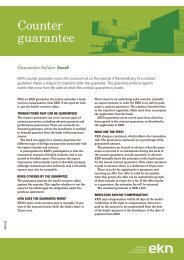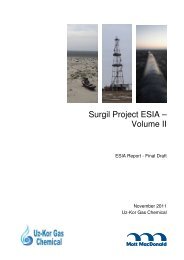Surgil ESIA Report - Volume III - EKN
Surgil ESIA Report - Volume III - EKN
Surgil ESIA Report - Volume III - EKN
Create successful ePaper yourself
Turn your PDF publications into a flip-book with our unique Google optimized e-Paper software.
“O’ZLITINEFTGAZ”<br />
open joint-stock company<br />
FS «Complex development of <strong>Surgil</strong> field<br />
with extracting of valuable components»<br />
necessary certificates.<br />
During emergency situations MES should be carried out much promptly and all samplings are<br />
performed more frequently and sampling grid is condensed covering emergency area and adjoining to it<br />
areas (sampling area should initially exceed emergency area). Analytical study is performed as<br />
promptly as possible to define the time of emergency elimination activities termination.<br />
MES program is designed for every natural environment components individually and includes<br />
four periods of supervision: background state, construction, operation and emergency situation (for<br />
each type of emergency individually).<br />
MES of atmospheric air within the site area, within the buffer area and within the dwelling<br />
settlements can be carried out with the help of automatic hardware and air and snow cover sampling at<br />
specific points defined taking into account the wind rose and pre-design of emissions spreading. Also<br />
nitrogen dioxide, carbon monoxide, sulfur dioxide, saturated hydrocarbons and hydrogen sulfide are to<br />
be monitored. Both organized and unorganized sources of emissions should be controlled. Besides the<br />
law on «Air protection» adopted on December the 27 th 1996, articles 24, 27, 28, normative basis of the<br />
air pollution MES is presented with the decrees by Cabinet of Ministers, Sanitary Norms and Rules and<br />
other documents.<br />
MES of the ground waters state and their potential contamination is carried out through the<br />
system of special inspection wells drilled near the potential point of contamination along the stream. In<br />
each well four times a year they measure ground waters level, water temperature and take out samples<br />
for further comprehensive chemical analysis. The most frequently controlled parameters of ground<br />
waters are the following; pH, nitrates, nitrites, phosphorous, nitrogen (ammonium, nitrate, nitrite),<br />
permanganate oxidability, iron, petrochemicals, heavy metals, etc.<br />
When carrying out background state of soils supervision they perform complex soil-chemical<br />
examination of soils for area objects in scale 1:5 000, and for linear – in scale of 1:10 000 and selection<br />
of key sections for further control. During construction period supervision they track soil covering<br />
response to anthropogenic impact: from key sections (background and check) they take samples for<br />
chemical analysis to control heavy metals, arsenic, organochlorine compounds, full range of oil<br />
hydrocarbons, etc. content. When assessing chemical composition changes special attention should be<br />
paid to the high-toxic contaminating substances appearance.<br />
After completion of construction recultivated areas are supervised for regeneration of soil<br />
covering’s initial agrochemical state.<br />
MES of vegetation is carried out on the sample areas for geobotanical control spatially combined<br />
with ones for soil covering control.<br />
Such areas are selected as a rule where there are typical plant associations, at the site bounds<br />
and on erosive areas. Sample areas are divided into control sections and strips where they control the<br />
following: species composition, abundance, vitality, vegetation strength and phytomass and fertility if<br />
necessary. Control section area depends on type of vegetation: for woody associations – 100-400m 2 ;<br />
for scrub and herb associations – 10m 2 ; for moss and lichen associations – 1m 2 .<br />
Rather often it is necessary to perform geobotanical survey during which they obtain data on<br />
plant associations’ composition and structure not only within the site and buffer area but within the<br />
whole affected by UGCC area as well including emergency situations. During geobotanical survey they<br />
get information about trees level, off-level vegetation; inventory protected and rare species of plants<br />
and their ecotope; perform territory zoning according to strength of UGCC influence upon the natural<br />
complex; carry out geochemical study including selection of plants for different special analyses.<br />
MES of the surface fauna includes the following: inventory and assessment of present state of<br />
animals’ ecotope and their number; assessment of biotopes transformation degree before construction<br />
started; assessment of ecotopes according to ecological risks of anthropogenic impact degree;<br />
assessment of animal world condition in the region (territorial populations of birds, mammals, reptiles,<br />
Book 5. Declaration of environmental impact concerning UGCC construction<br />
40



